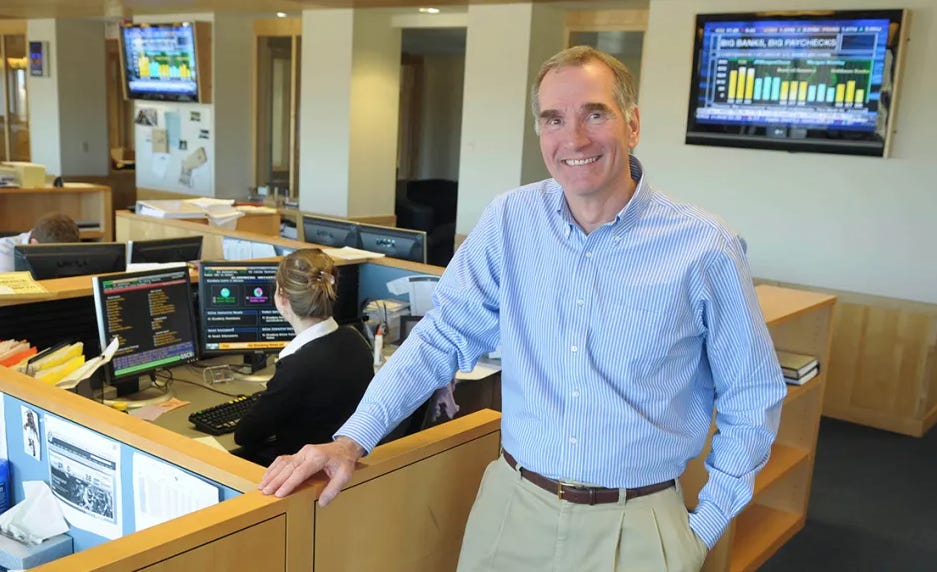Basket of eggs
My investing plan for 2023
What’s Graham up, it’s guys here :-) If you want to join 29,140+ smart investors and never miss an update on the market, hit the subscribe button below. It only takes a second and is completely free.
When you think of investment experts and fund managers, the image that might come to mind is of a high-flying Wall Street executive with hands-on experience. But some of the most profitable track records in investing come from a surprising space – Endowment investing. Universities in the US receive large donations that go into endowment funds. A small portion of the fund is used to finance their operations every year. The total amount of money managed in US university endowments is more than $675 Billion as of 2020.
The way institutions invested was quite conservative before the 80s. Most of them entrusted their funds to safe assets like bonds and cash. All that changed when David Swensen left Wall Street to join Yale as a professor and its Chief Investment Officer in 1985.
David Swensen was a protege of Nobel Prize winner Jim Tobin who researched the benefits of diversification. When he joined, Yale’s endowment fund had a little less than $1 Billion. David’s unconventional approach transformed the way endowments were invested, not just in Yale, but all over the US. In 2021, Yale’s portfolio had overtaken all funds except Harvard’s at a total of $31.2 Billion!
Despite the endowment’s fantastic performance, David came under fire in 2008 during the financial crisis when the Yale fund faced a loss of 24.6% due to its investment in illiquid assets (though the market itself was seeing a drawdown of 57%). But David continued to invest the same way, standing by two core principles:
Don’t put all your eggs in one basket. Diversification is a free lunch.
The opportunity cost of not investing in stocks is a bigger risk than “safe” investing in the long run.
What does this have to do with my investment plan for 2023? Everything.
We are going through an especially confusing time in recent market history. Stocks seem like unattractive investments in the short term. Real estate prices have just begun to decline, but Fed rates are poised to drop further. T-bills look attractive, but there might be even more lucrative options. What’s the right path?
Let me walk you through how David’s approach is playing into my thinking – and whether his convictions were proven right.
Why diversify?
You don’t have to read till the end to find out how I have split my assets. Here it is:
35% equities
35% real estate
22% treasuries
4% alternative assets
3% Bitcoin and Ethereum
The rationale behind this split – and how I plan to change it – is what you will find interesting. In my 20s, there was only one place I put all my money into – Real Estate. I would save up, buy a residential property, spruce it up, rent it out… And repeat the process. Literally every penny I had was tied up among seven properties in Southern California (Talk about putting all your eggs in one basket). The risk with tying up your assets in one type of investment is that it can force your arm into liquidating when you are least prepared.
As David Swensen elaborates in this amazing lecture, there are three factors that drive returns in the market:
Asset Allocation
Market Timing
Security Selection
While market timing and security selection (stock picking) are the areas that most investing “tips” are based on, it’s asset allocation that accounts for 90% of the variability in investing returns. This means that just deciding the right proportion of different assets in your portfolio and sticking to your plan has a far bigger impact on long-term performance than spending all your time picking assets or timing the market. I had to diversify my assets.
That’s exactly why I started looking into stocks and index funds in 2020.
Stocks – Risk and Reward
It’s not a great time to be talking about stocks. For most of you who started investing recently, the stock market might be testing your nerves. The market closed 19% down in 2022 and the last time we were anywhere close to this was in 2008, at the beginning of a global financial crisis. But once you zoom out a little, things start to make sense.
Stocks should always be a long-term investing strategy. When you look at stocks over a longer time horizon of 20-30 years, stocks have never lost money. The return on the S&P 500 has been positive over any 20-year rolling period, and the least it’s ever been was in 1948 at 4% – Not much different from a treasury bill. But most times, the stock market has had an average return of 7-10%.

The short term is where things get uncomfortable – If you buy and sell within a year, there’s a 73% chance of being profitable. But your chances increase to 80% in the second year, 90% in the fifth year, and 97% by the tenth year! I like those odds. I have always invested in stocks with the mindset that I’m going to put in the money and forget about it till 2040. So I’m sticking with that strategy, allocating 35% of my income into a mix of the S&P 500, a Total Stock Market fund, and International Index Funds. Now let’s talk about real estate.
Back to basics
I had made most of my money investing in real estate and spent all my time thinking and dreaming about it prior to 2020. After selling a couple of properties and struggling to find rental property deals, I put real estate on the back burner. But Dave Ramsey reminded me that it was my strength and that I would make more money in real estate than I would ever make in any other field.
So I’m returning to real estate, but with a twist. Fixing up multi-family properties was a lot of fun, and I love the process of getting a property ready from start to finish. But in the current market, there might be even better opportunities in commercial real estate: everything ranging from office and retail space, warehouses, restaurants, shipping, and any other space that a business might use for the next 5 to 20 years.
Commercial property prices are already down 13% from the peak – and they have the added advantage of a triple net (NNN), meaning that the tenant is responsible for paying the operating expenses like taxes, insurance, and maintenance fees. Unlike residential real estate, where the landlord is responsible for everything, this allows me to spend more time focusing on larger projects without being bogged down with the day-to-day runnings of a property.
The thing is, this is easier said than done – it isn’t going to be easy to find a good deal that fits all my requirements – but with Treasury rates paying 4-5%, commercial real estate should be selling at a significantly higher premium. When I find something that makes sense, I’ll make an offer and see what happens. I’m hoping that something will come along in the next 12 months (subscribe to stay posted!). Now let’s talk about how I round out my portfolio with other assets.
Factors driving returns
Obviously, I’m talking about my cars here – driving returns, get it?… Never mind. Seriously speaking though, one of the key principles in diversification is that the factors responsible for returns on different asset classes should be different. Since Fed rates influence stocks and bonds, splitting your money just between these two assets is not a wise decision. But something that is not correlated with the market could be a wise move.
That’s why I invested in a Ford GT (which is up 30% since I bought it) and a Tesla Roadster that has done much better this year than my Tesla stock holdings. Several of my watches are also now 20% up from what I paid for them. Admittedly, I put less than 5% of my net worth into these investments and I’m not advising you to go all in on exotic cars and Rolex watches… but if you can indulge your passions in a way that brings you future returns instead of costing you money, it’s worth looking into!
For example, Bone-stock Hondas, BMW Ms, and Tudors might be relatively undervalued… But do your research! Personally, I’ll be saving the cash for real estate in 2023. But I am consistently investing 3% of my money into Bitcoin and Ethereum. I’m prepared for the case that it may go to zero – but I’m willing to take that risk with 3%.
Cash is trash
I have mentioned in the past that holding cash might be the best thing to do in an overvalued market – but now that treasuries are paying anywhere from 3.5-4.5%, it makes no sense to store that money as cash. There are some fantastic high-yield savings options out there, so while you are making up your mind, you could consider treasuries as a standby. If you know for sure that you won’t need the money for the next 2 years, treasury bonds that pay 4% are great options too.
My rationale is to hold on to the money while looking for a good real estate deal, but till I find one, I get something on my investment rather than nothing.
Coming back to David Swensen: He was attacked for allocating money into assets like Venture Capital, Timber, Commodities, etc. that were seen as too risky for university endowments. But he stuck to his guns. After a lackluster year in 2008, the Yale fund led the industry with a 20.2% return in 2014. From 2010-2020, it was the third-best university endowment, and even the others were all led by Yale alumni.
The story has a tragic ending. David succumbed to cancer last year, at 67. His principles of diversification will continue to make a difference for decades.
As for my plans, it’s going to be more of the same – Dollar-cost averaging into the stock market, buying into treasuries, and waiting for the right opportunities in commercial real estate. I don’t foresee any wild opportunities, and as long as you draw up a plan and stick to the basics, you should be able to withstand anything Jerome Powell has in store for you…
Do you have an optimal mix of assets for your 2023 plan? Let me know in the comments.
Stay safe, stay invested and I will see you next week - Graham Stephan.
A lot of effort and research went into making this article, so if you found it insightful, please help me out by clicking the like button and sharing this article.





My plan for 2023
1. Income is the asset. Continue to build reliable income streams.
2. Double down on Real Estate.
3. Low to Medium Financial Leverage Positions.
4. Increase Partnership Leverages
Ontario, Canada
My Plan:
1: save 1 year of expenses (working as an real estate agent)
2: invest in index fund (MSCI World)
3: buy my first rental property (maybe cash)